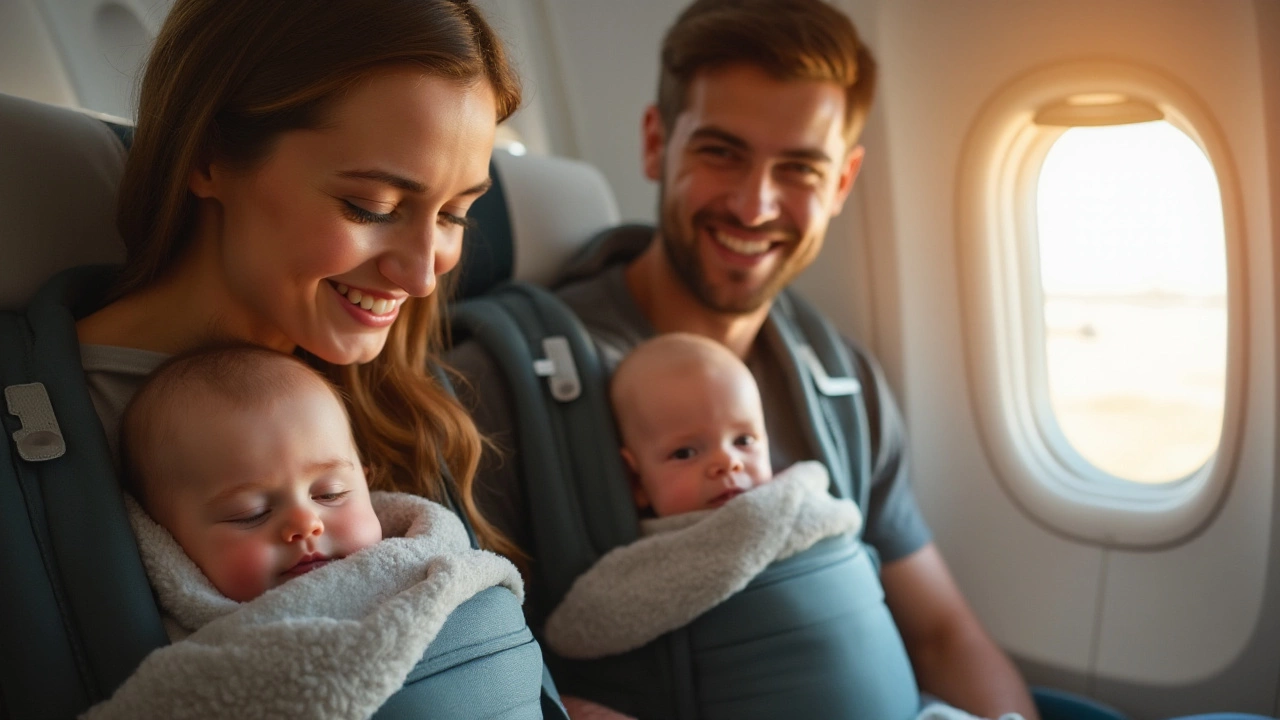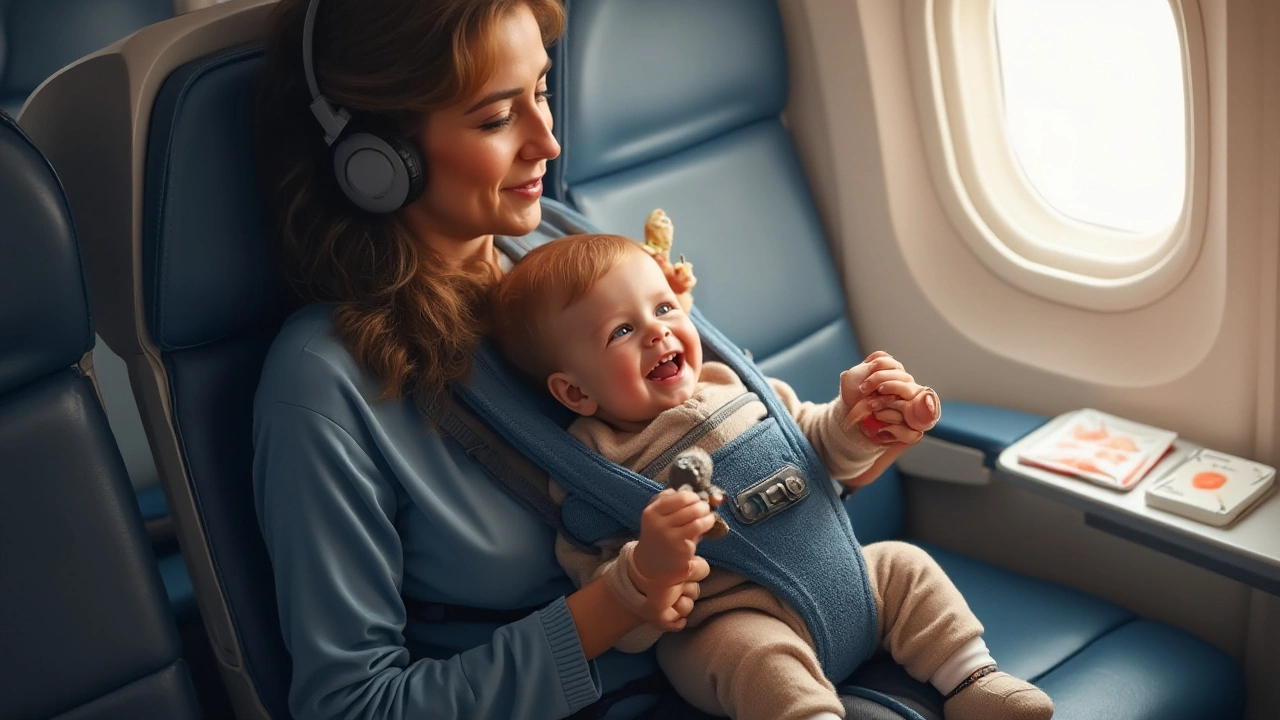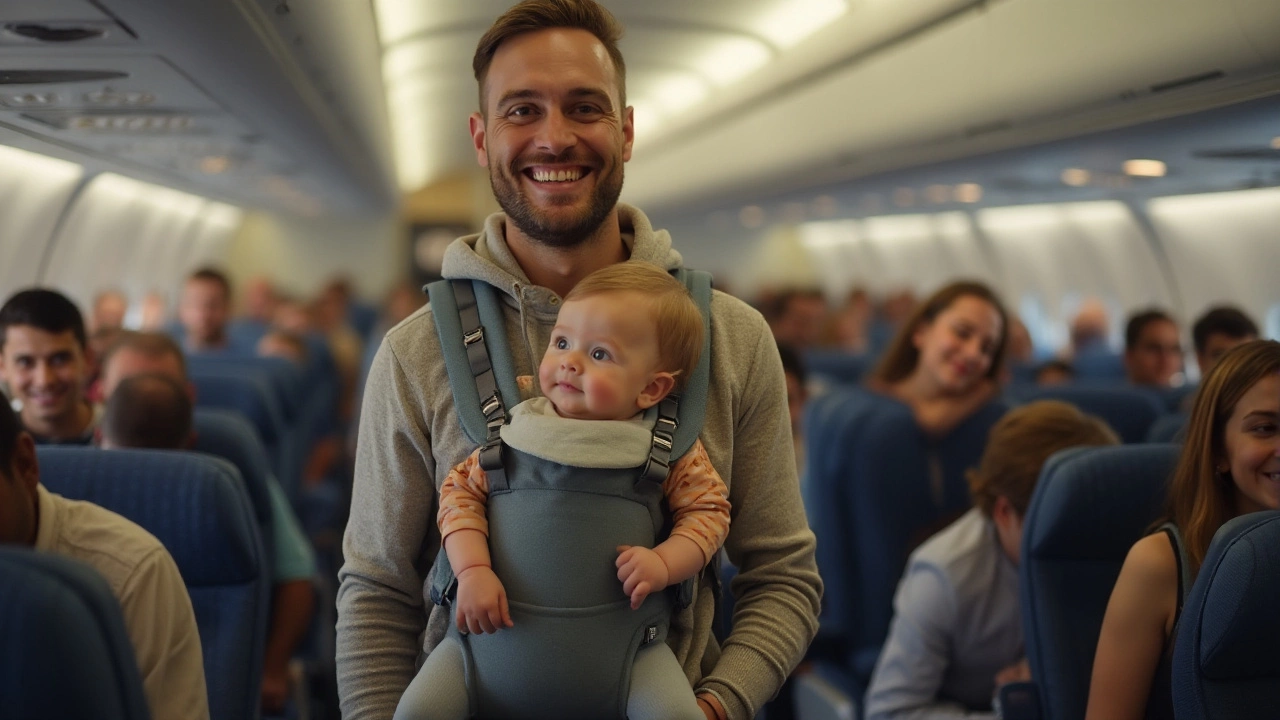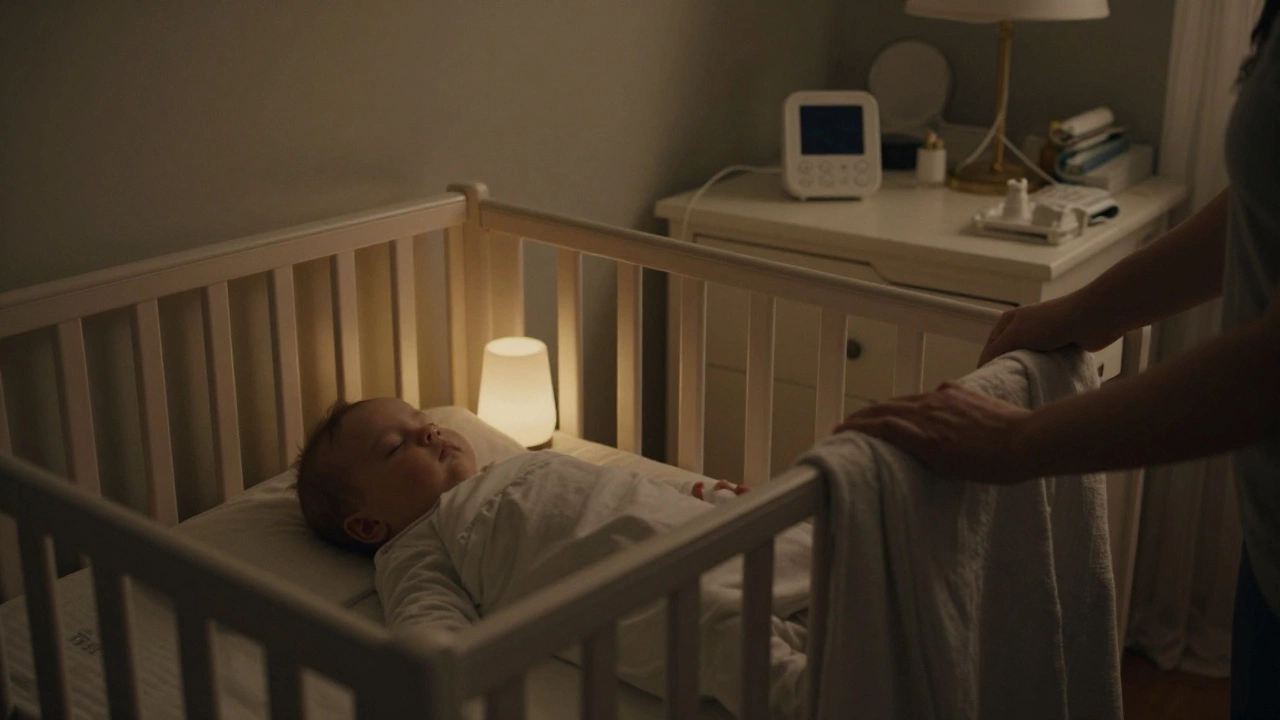Navigating Air Travel with Babywearing: A Complete Guide

As a parent eager to explore the world with your little one, the idea of boarding a plane can be both exciting and overwhelming. One common question among parents is whether they can use a baby carrier while traveling by air. Beyond convenience, there are questions of safety, airline regulations, and simply making the flight as pleasant as possible for everyone involved.
In this article, we'll navigate through the ins and outs of babywearing on planes, considering various aspects from airline rules to personal comfort. Whether you're a first-time parent or a travel-savvy mom or dad, there's something here to help make your journey smoother. Let’s uncover what you need to know before you take off with your baby snug against you.
- Understanding Airline Policies
- Safety Precautions on a Plane
- Comfort for You and Your Baby
- Benefits of Babywearing While Traveling
- Expert Tips for a Stress-Free Journey
Understanding Airline Policies
When you're planning to fly with an infant, it's crucial to dive into the specifics of airline policies regarding babywearing. Each airline may have its own set of rules and regulations concerning the safety and comfort of both the parent and child. Before embarking on your journey, it's wise to contact your airline directly or review their website for the most up-to-date policies. Many airlines allow the use of baby carriers during boarding and disembarking, which is a godsend for parents juggling boarding passes and carry-ons. However, they may require infants to be removed from carriers during takeoff and landing for safety reasons, a rule stipulated by aviation safety authorities worldwide. Reading the fine print can save a lot of hassle at the airport.
Despite these general guidelines, interpretations of policies can vary even within a single airline, depending on the flight crew's perspective. Some crew members might permit you to keep your baby snug in a carrier throughout the flight, while others may not. It's always beneficial to understand the reasoning behind these policies. The primary concern is safety; during any unexpected turbulence, securing an infant in a dedicated seat with an approved seat belt is safer than being in a carrier. It's a balance of adhering to regulations and doing what's best for your child. For example, the Federal Aviation Administration (FAA) in the United States recommends — though doesn't mandate — that infants occupy a dedicated safety seat. This measure is up to each passenger's discretion and parental judgment.
Consider the varying practices for international flights. International travel often involves stricter protocols due to regulations from aviation authorities in different countries. Airlines operating under the European Union Aviation Safety Agency (EASA) might have different stipulations compared to those in the U.S. or Asia-Pacific. It's also vital to consider connecting flights on different airlines, as carrier policies may differ. Take this into account when planning your trip itinerary and double-check with all involved airlines about their infant travel policies.
"A well-informed traveler will always have the upper hand," advises Julie Vallese, spokeswoman for Consumer Reports and a child safety expert. "Preparation not only minimizes stress but also ensures safety compliance and a happier flight experience for everyone involved."
To simplify things when traveling with an infant, here’s a practical piece of advice: bookmark relevant airline policy pages on your smartphone or tablet so you can quickly refer to them at the check-in counter or while speaking to airline staff. Keeping a printout of these rules can also be a helpful backup if digital access isn’t reliable. Being proactive about policy knowledge not only sets proper expectations but also empowers you to advocate confidently for your rights and comforts as a passenger. No one knows your reasons or comfort levels better than you, and an understanding of these common guidelines can help mitigate surprises.
Safety Precautions on a Plane
When preparing to travel with an infant, safety is paramount. Airlines have specific guidelines to ensure the well-being of your little one during the flight, which is why familiarizing yourself with these rules is important. Most airlines acknowledge that during takeoff and landing, your baby should be securely fastened in an approved car seat if you’ve purchased an extra seat. However, if you're planning to lap-sit, often the cabin crew will provide an extra seatbelt attachment to secure your baby.
An important point to consider is the turbulence factor, which can be unpredictable during any flight. Having your baby secure in a car seat provides the added safety in such cases, and allows parents a sense of relief knowing their child is safeguarded. Airline staff is generally very accommodating when it comes to ensuring that the car seat fits properly, and it’s wise to check in advance whether your seat model is certified for air travel. This small step can save a potential hassle at boarding.
"A well fastened baby car seat is as vital on a plane as it is on a road," says Janet Simons, a seasoned aviation safety expert. "Always double-check its compatibility with the aircraft's seat belts."
Moreover, babywearing during flights has its own merits, offering ease of movement to parents when shifting between seats or pacing the aisle to soothe your baby. Keep in mind that some airlines might require you to take your infant out of the carrier during certain phases of the flight. Before flying, it’s advisable to call ahead or check the airline's website for its specific babywearing policy.
Important Considerations
Consider the comfort of your baby and yourself when you decide to wear them while flying. Balance the temperature by dressing your baby in layers. Airplane cabins can be notoriously chilly, but the close physical contact in babywearing might lead to overheating. It is crucial to find the right balance, adjusting your and your baby's attire accordingly to keep them snug but not overheated.
Staying hydrated is another critical factor. Cabin air is dry, so both you and your baby should drink plenty of fluids. If you are breastfeeding, wearing your baby makes the process more discrete and convenient. It's also a great way to soothe your baby if they're distressed. Bring along a nursing cover if you prefer more privacy, and consider a baby sling that allows easy access while still providing support and comfort.
- Check airline policies on babywearing and car seats ahead of time.
- Ensure the car seat is certified for use on airplanes.
- Be prepared to adjust layers to manage your baby’s temperature.
- Stay hydrated with ample fluids throughout the flight.
- Pack a favorite toy or pacifier to help soothe your baby if needed.

Comfort for You and Your Baby
When it comes to plane travel, ensuring comfort for both you and your baby can truly make or break the experience. A stressful flight can feel eternal, but with thoughtful planning, babywearing can turn into a seamless and cozy journey. A well-chosen baby carrier not only keeps your hands free but also offers a familiar, snuggly environment for your infant, combating the sensory overload of an airport and aircraft. Long lines and lengthy waits are commonplace at airports; thus, keeping your baby close with a carrier allows for easier navigation through crowds and security checks. It's important to choose a carrier that evenly distributes the baby’s weight for minimal fatigue, especially on longer journeys.
Using a carrier on a plane can help recreate that soothing womb-like experience. Being tucked against you with the rhythmic motion of your breathing can lull infants into a sense of security and calm, potentially making for a quieter flight. To achieve this, ensure you use a carrier made from breathable fabrics, as cabin temperatures can fluctuate. Picking adjustable carriers that suit your body type is equally crucial, contributing to both your comfort and your child’s safety. As reported by the American Academy of Pediatrics, ensuring proper head and neck support is essential, particularly for newborns.
Air travel can be particularly daunting for little ones due to changes in cabin pressure affecting their ears. Nursing or offering a pacifier during takeoff and landing can help, but being in a carrier means they can stay closely connected to you, which can provide much comfort and mitigate any distressing noises around. Additionally, you might find your little one naps easier while being worn, as they are enveloped in your warmth and the gentle rocking of the plane. Nutritionist and mother-of-three, Amy Jones, once shared in 'Parents' magazine,
"Keeping your baby close can work wonders, not just for them, but for your peace of mind. A content baby is often a quieter baby, and on planes, that's a blessing."
Don't neglect your personal comfort. When you're comfortable, you can better tend to your baby's needs. Dress in layers, as flights often have unpredictable temperatures, and carry a neck pillow or travel blanket for additional comfort. It’s also worth considering your seating arrangement; an aisle seat might provide the extra wiggle room you need when maneuvering with your child. If you’re traveling with a partner, booking a window and an aisle seat may leave the middle seat free, offering more space. Some seasoned travelers recommend carrying a small, light, and sturdy bag to store essentials within easy reach, allowing you to retrieve wipes or toys without significant hassle.
Remember, maintaining a calm and composed demeanor can positively influence your baby's mood, so take deep breaths and soothe any in-flight anxiety with the knowledge that you've prepared well. This approach can augment your sense of control, invariably sending calming signals to your infant. Every bit of preparation, every ounce of determination to make your travels smooth pays off. With the right blend of preparation, awareness, and a clear focus on comfort, flying can be less daunting for both you and your loved one, turning it into a memorable adventure rather than a daunting task.
Benefits of Babywearing While Traveling
Embarking on an adventure with an infant can feel daunting, but babywearing offers a myriad of advantages that can transform the entire travel experience for both parent and child. One of the most immediate benefits is the convenience during the transition through airports, allowing parents to have their hands free for handling tickets, luggage, and grabbing a cup of coffee. It's a massive relief to keep your hands free while managing the constant hustle of traveling.
Moreover, many parents find that wearing their baby provides a sense of security to their child, especially during air travel. High altitudes and unfamiliar environments can make infants restless, but the closeness to a parent's heartbeat can have a calming effect, often helping them settle in for naps more easily than if they were in a stroller. The snugness of a comfortable carrier mimics the secure feeling of being in the womb, offering emotional comfort and stability.
From a health perspective, babywearing can also be beneficial. Direct skin contact facilitates bonding, releases oxytocin in both mother and baby, promoting maternal bonding and even improving sleep patterns. Not to mention, carrying your child this way can sometimes increase lactation, making breastfeeding on the go more feasible and less stressful. “Wearing my son on flights not only kept him calm, but it also made breastfeeding for comfort much more discreet and simpler,” shares Lydia Carmichael, a traveler and mother of two.
Practicality aside, being able to travel with your child in a baby carrier maximizes mobility. Navigating the aisles of a plane or moving quickly to catch a connecting flight becomes hassle-free since you're not encumbered by a bulky stroller or the uncertainty of potentially battling airport crowds with a young child. This advantage extends beyond airports; reaching your final destination with a baby in a carrier makes transitioning from taxis, public transport, or walking through crowded areas substantially easier.
Finally, there's a more subtle but equally compelling argument for using a carrier during air travel: the shared joy of exploration. Parents report that wearing their baby offers a shared perspective with their child. This eye-level connection allows infants to observe their surroundings easily, enriching their experience with sights and sounds from the safety of their parent's warmth. In a world full of possibilities, shared experiences in air travel become starter stories for future adventures!

Expert Tips for a Stress-Free Journey
Traveling by air with a baby can transform from a daunting task into a rewarding adventure with a few strategic moves. Experts agree that planning ahead and packing thoughtfully are your best allies. Begin by acquainting yourself with the specific policies of the airline you’ll be traveling with. Each one can have nuances in their babywearing allowances, so ensuring you’ve checked these details can save a lot of scrambling at the gate. Babywearing is not just about convenience but also about comfort. Choose a carrier designed for both prolonged use and ease, making sure it accommodates the age and size of your little one. Additionally, remember to dress in layers, as cabin temperatures can fluctuate. A comfortable and calm parent in transit often results in a baby mirroring that peace.
As you prepare for security checks, it’s essential to know that most airports will require you to remove your baby from their carrier as you pass through scanning stations. One seasoned traveler, Suzanne Smith, a longtime advocate of infant travel at "Travel Savvy Families," suggests clipping your carrier to your own clothing with carabiners. This way, your hands are free while keeping the carrier within reach, ensuring a smooth transition before and after security checks. Slow down your pace at this point—pull from it a chance to reorganize and catch your breath. After all, a smooth journey often combines adherence to rules with keeping calm.
"Traveling doesn't have to be stressful," says Julia Barrett, a travel consultant with two decades of experience. "The key is flexibility and understanding both yours and your child’s rhythms. Keep essentials like a pacifier, and snacks reachable, and use pockets in your clothing for quick access."
Upon boarding, if possible, choose a seat that gives you the most space, such as an aisle seat. This not only allows ease of movement but can also offer quick restroom access. Consider using a babywearing wrap that offers you the capability to breastfeed discreetly, if that's your choice, or that allows you to soothe your baby without much fuss. Remember that the hum of the plane can be soothing to babies, often lulling them into longer naps. Noise-canceling headphones for yourself might also be an asset, helping create an environment of tranquility amidst the hustle of travel.
Onboard Entertainment for Infants
Keeping your baby occupied on a flight can pose a challenge, but with some creativity, it becomes part of the adventure. Bring a small bag dedicated solely to toys and entertainment tailored to your baby’s preferences. Focus on quiet, engaging objects like fabric books with textures or teething toys packed with vibrant colors. Consider rotating the toys throughout the flight to maintain your baby’s curiosity. This strategy can not only keep your infant engaged but also free up space in your carry-on.
Finally, don’t shy away from accepting help. Fellow passengers, especially those who have traveled the parenting journey, often understand and are more than willing to offer a hand. Lean on the flight attendants too—their experience with traveling families often surpasses our own, and they can offer valuable assistance during the journey. Take each moment as it comes, and before you know it, you and your child could both be sound asleep, miles up in the air, unwinding in your new sky-high routine.


